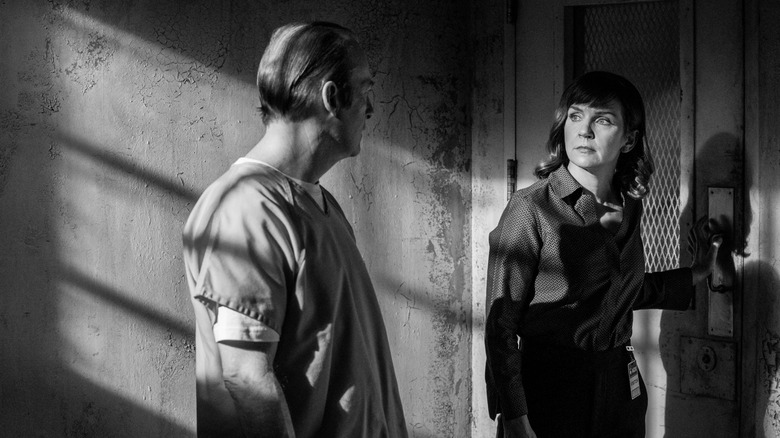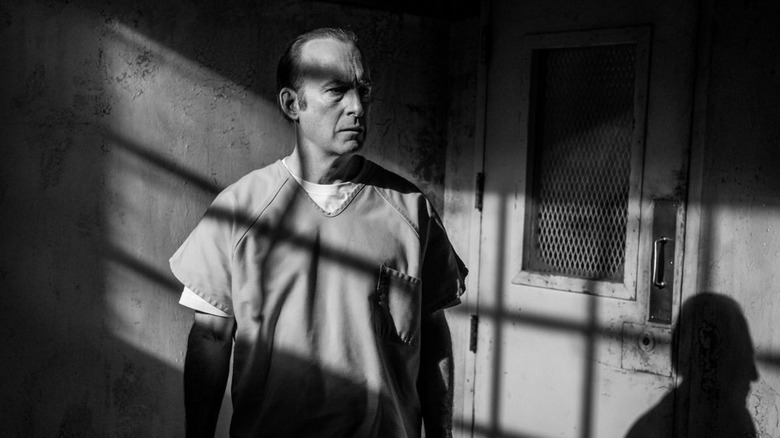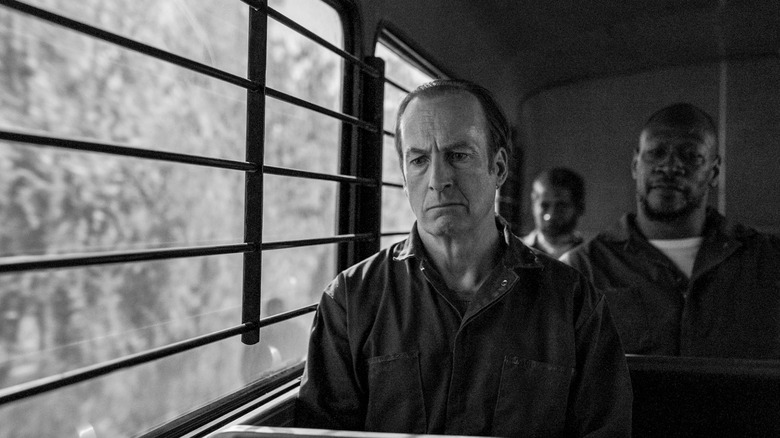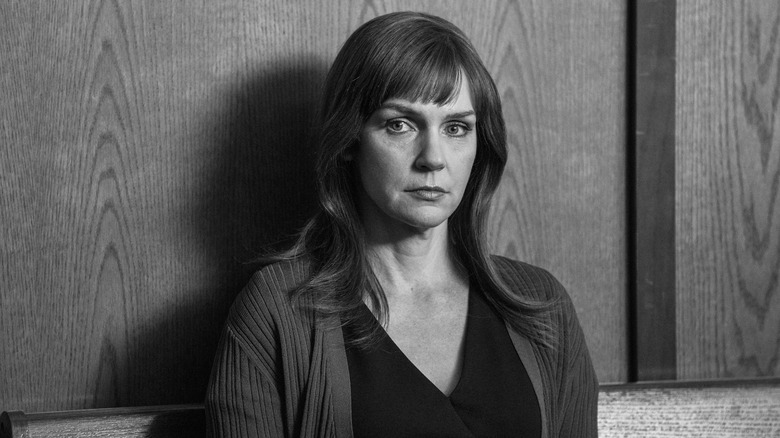Bob Odenkirk And Rhea Seehorn Break Down Jimmy And Kim's Final Scene In Better Call Saul
This post contains spoilers for the "Better Call Saul" series finale.
The series finale of "Better Call Saul," aptly titled "Saul Gone," is an incredible achievement in television that's still being discussed over four months after it aired. The tragedy of Slippin' Jimmy McGill was inevitable, as the prequel/sequel series had its trajectory set from the very first episode. While the transformation of Jimmy into Saul and then into Gene was inevitable, there were character relationships whose fate wasn't set in stone. Enter: Kim Wexler, played to perfection by Rhea Seehorn. Throughout six seasons, Kim's relationship with Jimmy and her eventual involvement in his schemes and deceitful nature made viewers wary of her future.
As stressful as it was to see Kim break bad, viewers were still invested in her relationship with Jimmy. Her character would also be the lynchpin that would lead to the full transformation of Jimmy into Saul Goodman halfway through the shows final season, making their relationship that much more meaningful, as well as Jimmy's acts as Saul Goodman that much more tragic. The criminal lawyer we see throughout "Breaking Bad" is a far cry from the Jimmy we know in "Better Call Saul." He only became such a slimy character because of the hurt he experienced from Kim leaving. Just as Kim's absence would be integral to the series, her reunion with Jimmy at the end would prove just as critical.
An unpredictably subtle ending
Bob Odenkirk and Rhea Seehorn broke down the final scene of the series for the February 2023 issue of Empire Magazine and what it meant for the characters to reunite in a post-"Breaking Bad" timeline. One of the first things discussed was the final shot of the series, which was the camera moving around a corner until Jimmy was no longer visible in a prison courtyard. It's a quiet ending for one of the best shows of the year, and Bob Odenkirk didn't see it coming. As he told Empire:
"I would not have predicted it. I would have predicted an ending with more explosions. I'm so glad there weren't. And yet the weird thing about it to me is that it really came from relaxing your grip on the characters."
Throughout "Better Call Saul," the show constantly stressed viewers about the fates of characters not named Jimmy, Gus, or Mike. Whether it was how the series would take Lalo Salamanca out of the picture or if Nacho Varga would get a happy ending (he didn't), there was uncertainty for new characters we'd grown to love over the six seasons. Even to a certain extent, fans were worried about Jimmy. The black-and-white flash-forwards featuring his new identity, Gene, made everyone unsure how his story would truly end.
Key moments of self-realization
"Better Call Saul" and "Breaking Bad" are wildly different in tone and character development. However, when it came to the end of both series, you can find striking similarities in moments of self-realization from the shows' main characters — characters who had been willfully ignorant of their dangerous and toxic flaws throughout their respective series. Similar to Walter White's admission in "Felina" that he did what he did because he "liked it," Bob Odenkirk believed the final scene in "Better Call Saul" was all about self-acceptance, as well as being a perfect way to end the series:
"One of the struggles I had, and Rhea [Seehorn] had this too, is that the characters were very emotionally intelligent about almost everybody they interacted with, yet had these blind spots regarding their own behavior. And in the end, the writers granted these characters the self-knowledge that I felt they always had. I thought it was beautiful."
Whereas Walter White died embracing his darker side, Jimmy McGill ended "Better Call Saul" at peace with himself and with Kim Wexler. "And in a weird way, he'd have to count [his relationship with Kim] as a very satisfying relationship to have had in his life. He traded his freedom for peace of mind and peace of heart, and I think that's a fair trade, for sure," Odenkirk noted.
One last moment of authenticity
The fate of Kim Wexler had been speculated about since "Better Call Saul" began, with viewers unsure if she would meet a grisly fate or somehow get her life ruined by Jimmy/Saul, leading to their separation. As it tuned out, Kim's guilt following the death of Howard Hamlin would lead her to disbar herself so that she could no longer practice law. Her black-and-white flash-forwards painted Kim as a shell of her former self, disappointed in Jimmy and what he had become. Still, Jimmy's last transformation into Saul Goodman would show Kim there's still some good-natured McGill in him.
Rhea Seehorn talked to Empire about Jimmy and Kim's final scene and how unexpectedly poignant it was. With hardly any dialogue, it was Bob Odenkirk's facial expressions that spoke volumes to Seehorn during filming:
"I hadn't realized the way Bob-as-Jimmy was going to look at me, and it was so arresting. To me, it was so much about him letting her know, 'I'm okay, the best of me that you always saw is alive and well,' and I think she's trying to let him know, 'I see that.' She still loves him."
Jimmy and Kim's relationship is pivotal to the series, so closure is necessary. To Rhea Seehorn, this final scene of the series was one last moment of intimacy and authenticity between the two characters:
"The entire series, these two people had all sorts of different masks they wore out in the world, and they only truly felt seen by each other. That's what that last moment felt like to me."
"Better Call Saul" is an incredible series with stellar character work to the end. It proves a great series doesn't need a loud, violent conclusion like "Breaking Bad." Instead, it chose to stay true to its characters and story, delivering a nuanced and quiet yet deeply emotionally-resonant conclusion.



